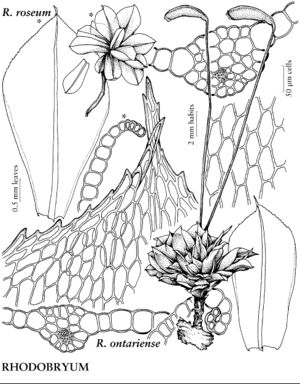Rhodobryum
Laubm. Deutschl. 2: 444. 1892.
| Taxon | Illustrator ⠉ | |
|---|---|---|
 | Rhodobryum ontariense Rhodobryum roseum | Patricia M. Eckel Patricia M. Eckel |
Plants large, in dense mats, dark green or olive green, sometimes red. Stems 1–5 cm, rosulate, unbranched or sometimes innovations arising from below terminal rosette, stolons present; rhizoids few-to-many, at base of stem or arising as macronemata in leaf-axils, micronemata absent on leafy stems. Leaves strongly contorted and shrunken when dry, erect-spreading when moist, ovate, obovate, or spathulate, flat, 3–10 mm; base not decurrent; margins revolute proximally, to mid leaf or beyond, or to near apex, strongly serrate from mid leaf to apex, 1-stratose, limbidium of elongate thickened cells, sometimes weak or absent; apex acute, broadly acute, or cuspidate; costa subpercurrent to more often percurrent to short-excurrent, hairpoint or apiculus often recurved, stereid band small or absent, guide cells enlarged, in 2–4 layers; alar cells not differentiated; laminal areolation heterogeneous; proximal laminal cells elongate-rectangular, 3–4: 1; medial and distal cells hexagonal, 3–4: 1, walls thick, pitted. Specialized asexual reproduction absent. Sexual condition dioicous; perigonia and perichaetia terminal; inner perigonial leaves small, broad, over-arching enlarged disclike pale perigonia with abundant paraphyses; inner perichaetial leaves somewhat differentiated, smaller and narrower than surrounding rosette leaves. Seta 1–8 per perichaetium, straight to slightly flexuose. Capsule inclined to nutant, oblong to cylindric, 3–5 mm; hypophysis differentiated but very short; operculum short-conic; peristome double; exostome brown or yellowbrown proximally, hyaline near apex, teeth lanceolate, acuminate; endostome not adherent to exostome, basal membrane high, segments lanceolate to subulate, perforate, cilia 2–4, nodose to appendiculate. Spores shed singly, 16–24 µm, finely papillose, yellowbrown.
Distribution
Nearly worldwide, except Antarctica, temperate to tropical regions
Discussion
Species ca. 25 (2 in the flora).
Rhodobryum is characterized by relatively large plants with leaves in a distinct rosette (at least in the flora area), stoloniferous primary stems, and costa with guide cells in two or more layers and stereid band reduced. The leaves are small and scalelike proximally, becoming enlarged and crowded distally; the proximal laminal cells are as long as 100 µm; the medial and distal cells are 25–35 × 50–80 µm; the seta is red or brown, long-exserted, and 2–5 cm; and the capsules are brown to red-brown and slightly curved and narrowed to the sometimes oblique mouth. The chromosomes of Rhodobryum are distinctly different from those of Bryum and Rosulabryum (H. P. Ramsay and J. R. Spence 1996). As in Roellobryon and Rosulabryum, more than one sporophyte can mature from the same perichaetium. Roellobryon differs from Rhodobryum by its lack of stolons, less contorted shiny pale green leaves that are finely rugose, and much larger laminal cells. Robust specimens of Rosulabryum andicola and R. canariense differ in their strongly developed stereid band with a single layer of guide cells, smaller leaves, lack of stolons, and presence of rhizoidal tubers and filiform leaf axil gemmae.
Selected References
None.
Lower Taxa
Key
| 1 | Leaves 18-55 in rosettes, usually more than 20; margins strongly revolute to beyond mid leaf; costal stereid bands distinct, reaching dorsal epidermal layer, without intervening layer of thin-walled cells. | Rhodobryum ontariense |
| 1 | Leaves 18-22 in rosettes; margins revolute to mid leaf or less; costal stereid bands small, not reaching dorsal epidermal layer, with at least one distinct intervening layer of thin-walled cells. | Rhodobryum roseum |
"narrower" is not a number."narrow" is not a number.